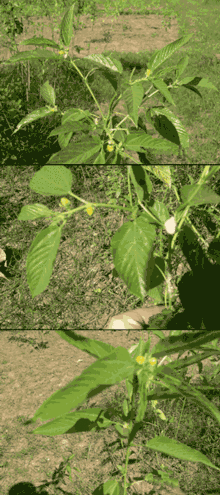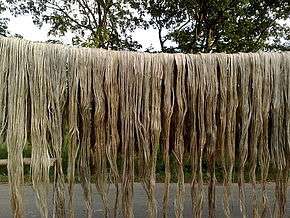Jute cultivation

Jute is one of the important natural fibers after cotton in terms of cultivation and usage. Cultivation is dependent on the climate, season, and soil. Almost 85% of the world's jute cultivation is concentrated in the Ganges Delta.
This fertile geographic region is shared by both Bangladesh and India (mainly West Bengal). China also has a dominating place in jute cultivation. On a smaller scale, Thailand, Myanmar (Burma), Pakistan, Nepal, and Bhutan also cultivate jute.
Cultivation
To grow jute, farmers scatter the seeds on cultivated soil. When the plants are about 15–20 cm tall, they are thinned out. About four months after planting, harvesting begins. The plants are usually harvested after they flower, before the flowers go to seed. The stalks are cut off close to the ground. The stalks are tied into bundles and soaked in water for about 20 days. This process softens the tissues and breaks the hard [pectin] bond between the bast and [Jute hurd] (inner woody fiber stick) and the process permits the fibres to be separated. The fibres are then stripped from the stalks in long strands and washed in clear, running water. Then they are hung up or spread on thatched roofs to dry. After 2–3 days of drying, the fibres are tied into bundles. The suitable climate for growing jute is a warm and wet climate, which is offered by the monsoon climate during the fall season, immediately followed by summer. Temperatures ranging from 25-30 °C and relative humidity of 70%–90% are favorable for successful cultivation. Jute requires 160-200 cm of rainfall weekly with extra needed during the sowing period. River basins or alluvial or loamy soils are best for jute cultivation.Jute cultivation in red soils may require high dose of manure and PH range between 4.8-5.8 is best for its cultivation. Plain land or gentle slope or low land is ideal for jute cultivation.Since the jute seeds are small in size ,land should be prepared to fine tilth.Couple of ploughing will make the soil to fine tilth.
Retting

Retting is the process of extracting fibers from the long lasting life stem or bast of the bast fiber plants. The available retting processes are: mechanical retting (hammering), chemical retting (boiling & applying chemicals), steam/vapor/dew retting, and water or microbial retting. Among them, the water or microbial retting is a century old but the most popular process in extracting fine bast fibers. However, selection of these retting processes depends on the availability of water and the cost of retting process.
To extract fine fibers from jute plant, a small stalk is harvested for pre-retting. Usually, this small stalk is brought before 2 weeks of harvesting time. If the fiber can easily be removed from the Jute hurd or core, then the crop is ready for harvesting.
After harvesting, the jute stalks are tied into bundles and submerged in soft running water. The stalk stays submerged in water for 20 days. However, the retting process may require less time if the quality of the jute is better. In most cases, the fiber extraction process of bast fibers in water retting is done by the farmers while standing under water.
When the jute stalk is well retted, the stalk is grabbed in bundles and hit with a long wooden hammer to make the fiber loose from the jute hurd or core. After loosing the fiber, the fiber is washed with water and squeezed for dehydration. The extracted fibers is further washed with fresh water and allowed to dry on bamboo poles. Finally, they are tied into small bundles to be sold into the primary market.
Major producers
The Ganges delta contributes more than 80% of the jute production in the world. The Ganges delta can be sub-divided into the following geo-graphical regions in terms of jute cultivation:
- Jat Area (Brahmaputra Alluvium): This comprises part of the districts of Dhaka, Mymensingh, Tangail, and Comilla of Bangladesh. The area annually receives fresh deposit of silts carried down by the flood water. Soils are acidic in, the texture varies from sand loam to clay loam. According to commercial quality, the best quality Jute, the Jat type, grows in this area.
- District Area (Ganges Alluvium): This comprises part of the districts of Kushtia, Jessore, Khulna, Rajshahi, Pabna, and Dhaka of Bangladesh and major portion of West Bengal of India. This area has soil of slight alkaline clay loam to light loam in gray to dark gray color. The type of Jute grown in this area is known as District Jute, which is next to Jat Jute in order of quality. The jute fibre grown in this region is further divided into two major varieties, such as: Hard District Jute and Soft District Jute.
- Northern Area (Teesta Silt): This comprises part of Dinajpur, Rangpur districts, East Bogra, and Sirajganj of Bangladesh and some parts of North Bihar Purnea and West Bengal of India. The region has sandy soil with low moisture retention capacity. Soil retention is slightly acidic. Northern type of Jute is inferior quality of the three commercial types.
Strengths of major jute producing countries
India, China, and Bangladesh are the three major producers in the cultivation or production of jute fiber.
- India has taken advantage of recent improvements in the cultivation of jute to become the largest producer or cultivator of jute in the world. Using advanced production techniques, India also has dominance over the worldwide jute products market. Due to national law to use jute as packaging materials, India is the largest consumer of jute in the world.
- Bangladesh is currently the second largest producer of jute fiber, now over taken by India. The Jat Area, popular for highest quality of jute fiber is located in Bangladesh. Therefore, Bangladesh is able to supply the highest quality of jute fiber in the world. However, Bangladesh falls behind its other competitors in applying recent technological advancements. In terms of world export of jute fiber, Bangladesh's share is more than 70%, which makes Bangladesh the largest exporter of jute fiber in the world.
- China is the third largest in terms of jute cultivation. Due to China's huge population, the Chinese are not emphasizing the cultivation of jute, as it competes with other necessary crops. Due to modern effective agriculture, they have the highest yield of jute fiber in the world.
History
For centuries, jute has been an integral part of the culture of East Bengal and some parts of West Bengal, precisely in the southwest of Bangladesh. Since the seventeenth century, the British started trading in jute. During the reign of the British Empire jute was also used in the military. British jute barons grew rich processing jute and selling manufactured products made from jute. Dundee Jute Barons and the British East India Company set up many jute mills in Bengal and by 1895 jute industries in Bengal overtook the Scottish jute trade. Many Scots emigrated to Bengal to set up jute factories. More than a billion jute sandbags were exported from Bengal to the trenches during World War I and also exported to the southern United States region to bag cotton. It was used in the fishing, construction, art and the arms industry. Initially, due to its texture, it could only be processed by hand until it was discovered in Dundee that by treating it with whale oil, it could be treated by machine.[1]
References
- ↑ "BBC Two - Brian Cox's Jute Journey". BBC. 2010-02-24. Retrieved 2016-09-20.
External links
| Wikimedia Commons has media related to Jute. |